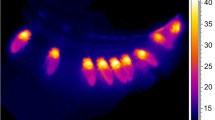Abstract
The objective of this research is to utilize mixed integer programming, which is a well-known technique for optimization, in order to determine the most effective location for honeybee colonies. The solution is proposed taking into account the nectar-secreting potential of flowering forest and agricultural crops in 13 chosen regions located in Northeastern Bulgaria. The outcome of this study is a broad model that can determine the optimal distribution of honeybee colonies regardless of the size or layout of a field, as well as the variety of plants present. Synthetic and genuine data are examined through numerical simulations, with the aim of attaining a high degree of similarity between the experimental and simulated results.
Access this chapter
Tax calculation will be finalised at checkout
Purchases are for personal use only
Similar content being viewed by others
References
Agro-statistic, Department to the Ministry of Agriculture, Food and Forestry. https://agri.bg/files/documents/2019/03/22%D0%9F%D1%87%D0%B5%D0%BB%D0%B0%D1%80%D1%81%D1%82%D0%B2%D0%BE.pdf
Atanasov, A., Hristakov, I., Petrov, M.: An approach for determination of an optimum honey bee colony’s density based on the productive potential of the blooming vegetation in Northeast part of Bulgaria in Ruse region. In: Ecologica, Belgrade, Serbia, pp. 221–224 (2017). ISBN 0354-3285
Al-Ghamdi, A., Adgaba, N., Getachew, A., Tadesse, Y.: An approach for determination of an optimum honey bee colony’s carrying capacity based on the productive and nectar secretion potential of bee forage species. Saudi J. Biol. Sci. 23(1), 92–100 (2016)
Allen-Wardell, G., et al.: The potential consequences of pollinator beelines on the conservation of biodiversity and stability of food crop yields. Conserv. Biol. 12(1), 8–17 (1998)
Barnsley Beekeeper Association, Keeping Bees - Apiary Set Up. http://barnsleybeekeepers.org.uk/index.php/keeping-bees/apiary-setup
Bradbear, N.: Bees and their role in forest livelihoods: a guide to the services provided by bees and the sustainable harvesting, processing and marketing of their products. Food and Agriculture Organization of the United Nations, Rome (2009)
British Beekeepers Association. Choosing an Apiary site. British Beekeepers Association Advisory Leaflet B11 3rd edn. British Beekeepers Association, Warwickshire (2006)
Brosi, B.J., Armsworth, P.R., Daily, G.C.: Optimal design of agricultural landscapes for pollination services. Conserv. Lett. 1(1), 27–36 (2008)
Esteves, R.J.P., Villadelrey, M.C., Rabajante, J.F.: Determining the optimal distribution of bee colony locations to avoid overpopulation using mixed integer programming. J. Nat. Stud. 9, 79–82 (2010)
Free, J.: Insect Pollination of Crops. Academic Press, London/New York (1993)
Gallai, N., Salles, J.M., Settele, J., Vaissiere, B.E.: Economic valuation of the vulnerability of the world agriculture confronted with pollinator decline. Ecol. Econ. 68, 810–821 (2009)
Gavina, M.K.A., Rabajante, J.F., Cervancia, C.R.: Mathematical programming models for determining the optimal location of beehives. Bull. Math. Biol. 76(5), 997–1016 (2014). https://doi.org/10.1007/s11538-014-9943-9
Georgiev, S.G., Vulkov, L.G.: Parameter identification approach for a fractional dynamics model of honeybee population. In: Lirkov, I., Margenov, S. (eds.) LSSC 2021. LNCS, vol. 13127, pp. 40–48. Springer, Cham (2022). https://doi.org/10.1007/978-3-030-97549-4_4
Grace, A.: Optimization Toolbox. For Use with Matlab. User’s Guide. The MathWorks, Inc., Natick (1995)
Kevan, P.G.: Pollinators as bioindicators of the state of the environment: species, activity and diversity. Agr. Ecosyst. Environ. 74, 373–393 (1999)
Klein, A.-M., et al.: Importance of pollinators in changing landscapes for world crops. Proc. R. Soc. B: Biol. Sci. 274(1608), 303–313 (2007)
Miettinen, K.: Nonlinear Multiobjective Optimization. Kluwer Academic Publishers, Boston (1999)
Pareto, V.: Notice biographique. Centre d’Etudes Interdisciplinires Walras Pareto, Universtu de Lausane (2003). http://www.unil.ch/cwp/pareto_bio.htm
Replaces Honey Bees and Blueberry Pollinations Cooperative Extension Bulletin 629. https://extension.umaine.edu/blueberries/factsheets/bees/629-honey-bees-and-blueberry-pollination/
Statnikov, R.B., Matusov, J.B.: Multicriteria Optimization and Engineering. Chapman & Hall, New York (1995)
Statnikov, R.B.: Multicriteria Design: Optimization and Identification. Kluwer Academic, Dordrecht (1999)
Zadeh, L.A.: Optimality and non-scalar-valued performance criteria. IEEE Trans. Automat. Contr. AC-8, 59–60 (1963)
Zhelyazkov, P., Atanasov, A., Hristakov, I.: Study on the honey productive potential of the bee forage species in Northeast part of Bulgaria region. In: X International Scientific Symposium “Farm Machinery and Processes Management in Sustainable Agriculture”, Lublin, Poland (2019)
Acknowledgements
The study is supported by the Bulgarian National Science Fund under Project KP-06-PN 46-7 “Design and research of fundamental technologies and methods for precision apiculture”.
Author information
Authors and Affiliations
Corresponding author
Editor information
Editors and Affiliations
Rights and permissions
Copyright information
© 2023 The Author(s), under exclusive license to Springer Nature Switzerland AG
About this paper
Cite this paper
Atanasov, A., Georgiev, I.R., Petrov, M. (2023). Determination of Honeybee Colony’s Placement for Optimum Bee Foraging. In: Georgiev, I., Kostadinov, H., Lilkova, E. (eds) Advanced Computing in Industrial Mathematics. BGSIAM 2019. Studies in Computational Intelligence, vol 1111. Springer, Cham. https://doi.org/10.1007/978-3-031-42010-8_2
Download citation
DOI: https://doi.org/10.1007/978-3-031-42010-8_2
Published:
Publisher Name: Springer, Cham
Print ISBN: 978-3-031-42009-2
Online ISBN: 978-3-031-42010-8
eBook Packages: Intelligent Technologies and RoboticsIntelligent Technologies and Robotics (R0)




